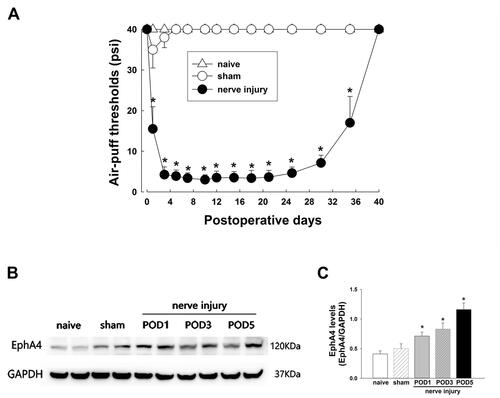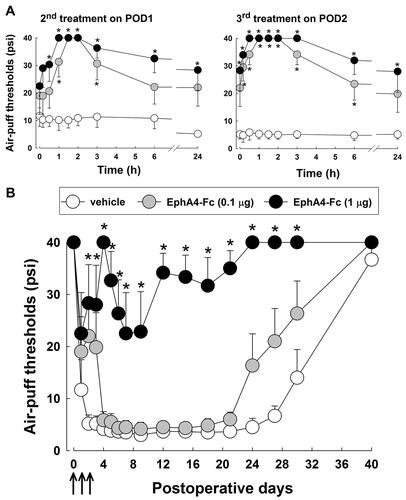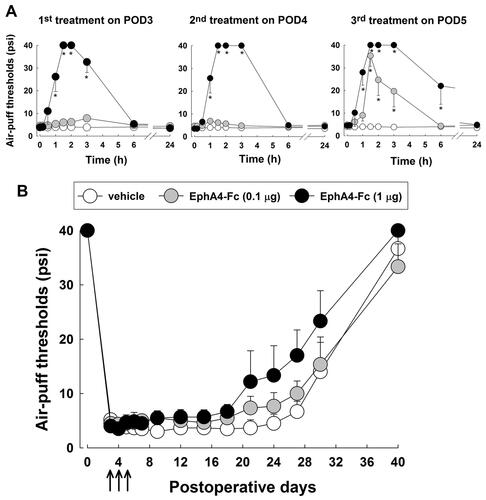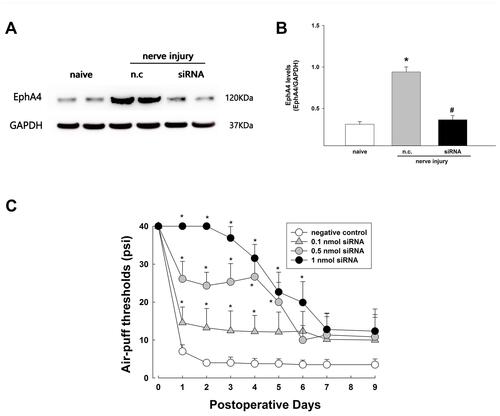Figures & data
Figure 1 Changes in air-puff thresholds and EphA4 expression after inferior alveolar nerve injury. (A) Inferior alveolar nerve injury produced significant mechanical allodynia compared with the sham-operated group. The cut off pressure was 40 psi, and naïve animals did not respond to pressures less than 40psi. There were 8 animals in each group. (B and C) Inferior alveolar nerve injury increased EphA4 expression in the ipsilateral trigeminal subnucleus caudalis compared with the sham group. GAPDH was used as a loading control. There were 6 animals in each group. The values shown are the mean ± SEM. *P < 0.05, sham vs nerve injury group.
Abbreviation: POD, postoperative day.

Figure 2 Effects of a single treatment with EphA4-Fc, an EphA4 receptor antagonist, on mechanical allodynia in rats with inferior alveolar nerve injury on POD3. Intracisternal administration of EphA4-Fc (1 or 10 μg) produced anti-allodynic effects compared with that of the vehicle. The values shown are the mean ± SEM. There were 8 animals in each group. *P < 0.05, vehicle vs EphA4-Fc-treated group.

Figure 3 Effects of early treatment with EphA4-Fc on mechanical allodynia after inferior alveolar nerve injury before chronic pain was established. (A) Daily treatments with EphA4-Fc (0.1 or 1 μg) significantly alleviated mechanical allodynia on POD 1 and 2 (second and third treatment). (B) Intracisternal treatment with EphA4-Fc (0.1 or 1 μg) for 3 days starting on POD 0 (early treatment protocol) produced significant prolonged anti-allodynic effects compared with vehicle treatment. Arrows indicate the treatment with EphA4-Fc. The values shown are the mean ± SEM. There were 8 animals in each group. *P < 0.05, vehicle vs EphA4-Fc-treated group.
Abbreviation: POD, postoperative day.

Figure 4 Effects of daily treatment with EphA4-Fc on mechanical allodynia after inferior alveolar nerve injury after chronic pain was established. Either EphA4-Fc or vehicle was administered intracisternally beginning on POD 3 for three consecutive days. (A) Daily treatment with a low dose of EphA4-Fc (0.1 μg) did not produce anti-allodynic effects except on POD 5 (third treatment). Administration of EphA4-Fc (1 μg) significantly reduced mechanical allodynia on POD 3, 4, and 5 (first - third treatment). (B) Intracisternal treatment with EphA4-Fc (0.1 or 1 μg) for 3 days starting on POD 3 (late treatment protocol) did not produce any prolonged anti-allodynic effects when chronic pain was already established. The arrows indicate treatment with EphA4-Fc. The values shown are the mean ± SEM. There were 8 animals in each group. *P < 0.05, vehicle vs EphA4-Fc-treated group.
Abbreviation: POD, postoperative day.

Figure 5 Effects of EphA4 siRNA on EphA4 expression and neuropathic mechanical allodynia after inferior alveolar nerve injury caused by a malpositioned dental implant. (A and B) Western blot analysis revealed that intracisternal administration of EphA4 siRNA downregulated EphA4 expression compared with the negative control (NC). The values shown are the mean ± SEM. There were 6 animals in each group. *P < 0.05, sham group vs negative control. #P < 0.05 negative control group vs EphA4 siRNA-treated group. (C) Intracisternal treatment with EphA4 siRNA produced significant anti-allodynic effects. A high dose (1 nmol) of EphA4 siRNA produced prolonged anti-allodynic effects until 6 days after treatment. The values shown are the mean ± SEM. There were 9 animals in each group. *P < 0.05 negative control vs EphA4 siRNA-treated group.
Abbreviation: n.c., negative control.

